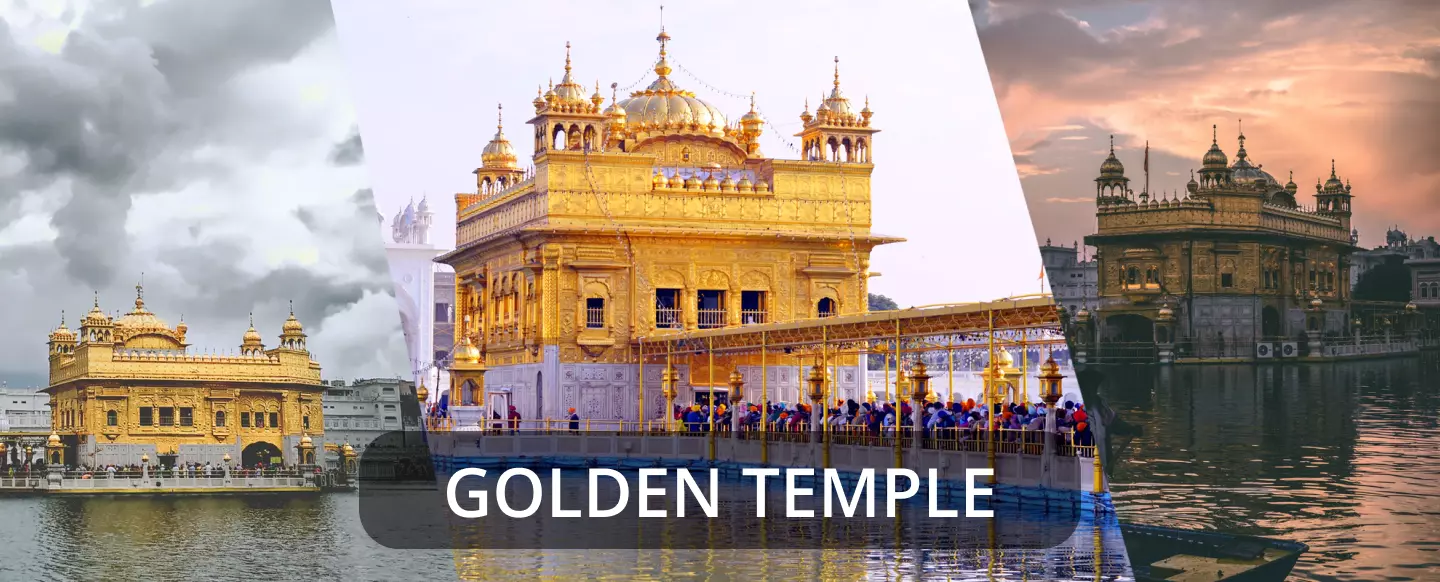
One of the most beautiful, tranquil, and spiritual places in India, the Golden Temple, also known as Shri Harmandir Sahib, is the holiest shrine in all of Sikhism. Nestled at the heart of the beautiful city of Amritsar in Punjab , the Golden Temple is one of the most visited religious places in India, and not just by the locals, but by tourists from across the globe. The stunning golden façade of the temple, its intricate architecture, surrounding serene pond, and the daily Langar (community kitchen) is what keeps the visitors and devotees visit the place again and again. The Golden Temple welcome devotees and visitors from all religions and faiths and serves over 1 lakh people everyday in langar from all walks of life.
Harmandir Sahib Golden Temple is a two-storeyed structure with its top-half covered in over 400 kg of real gold leaf which earned it its current name. The construction of this magnificent structure began in 19th century by Maharaja Ranjit Singh, the founder of the Sikh empire. The remaining structure is made of white marble carved with precious and semi-precious stones and motifs done in Pietra Dura technique. The part where the shrine is located is the main temple which is the part of the expansive complex known Harmandir Sahib or Darbar Sahib to the Sikhs. All the edges of the compound are surrounded by some more shrines and small monuments and the spiritual focus is the Amrit Sarovar, the water tank that encloses the shimmering central shrine. The Guru Granth Sahib, the holy book of Sikhs, is placed inside this shrine every morning.
There is a Sikh Museum inside the main entrance clock tower which depicts the oppression faced by the Sikhs during the Mughal empire, the British Raj, and the Central Government of 1984. The Golden Temple is a significant part of the Sikh community and is visited by every Sikh once in the lifetime no matter where they live. The peace and solace it offers while you sit beside the Amrit Sarovar is something worth experiencing once in the lifetime, and to collect that memory to rejoice forever.
Harmandir Sahib Golden Temple is built on the land, which was chosen by Guru Amar Das, the third Guru of Sikhs. One of his disciples, Ram Das, who then became the fourth Sikh Guru commenced the construction of the man-made pool (Amrit Sarovar) which got finished in 1577. In 1581, Guru Arjan started building the Golden Temple which got completed after eight years in 1589.
But this drew the attention of Mughals who were ruling India at the time, and the temple was seized by them. In 1762, the Afghan ruler Ahmad Shah Durrani had the Golden Temple blown up with gunpowder. Two years after this, in 1764, Baba Jassa Singh Ahluwalia – a prominent Sikh leader, collected donations to rebuild the sacred Golden Temple. A new main gateway called Darshan Deorhi and sanctum were built by 1776. The floor around the pool which was made for the temple earlier was completed in 1784, after which a canal was done to bring in fresh water for the pool from the nearby Ravi River, finally completing the construction.
The Harmandir Sahib Gurudwara temple have been attacked and damaged several times by the Mughal and the Afghan armies, but the Sikhs restored it every time. The founder of the Sikh empire, Maharaja Ranjit Singh, renovated the temple with copper and marble in 1809 and it was later overlaid with the Sanctum of gold leaf in 1830, giving the gurudwara the name Golden Temple.
Harmandir Sahib Amritsar was also the center of conflict during the Punjabi Suba Movement and Singh Sabha Movement between 1883 and 1920. In 1984, the then Prime Minister of India ordered an attack on the armed Sikh militants hiding inside the Golden Temple. In that attack, over 500 people died, and the temple premises faced sever damage which was repaired by the Sikh community who denied the help of Central Government and brought back the beauty of the Golden Temple.

Though a Sikh temple, the Golden temple’s architecture is a mixture of Indo-Islamic Mughal and the Hindu Rajput architecture. The Swarna Mandir is 67 feet high and has been constructed as a two-storey structure. It appears to be floating at the end of a causeway and has an elegant marble at the lower level that is adorned with animal and flower motifs in pietra dura work, which can also be seen on the Taj Mahal. The second level is a stunning floor defined in intricately carved gold panels and topped by a 750kg gold gilded dome. Just outside the inner sanctum sits the musicians and the priests who are ceaselessly chanting the Guru Granth Sahib making the atmosphere even more religiously intense.
The Harmandir Sahib (central temple) is joined to the pathway by a marble causeway known as the Guru’s Bridge. This path depicts the journey of the soul after death. The tank at the center of the compound is supported by marble stairways and is considered to have healing powers that can cure many skins related and other diseases. Some of the main elements inside Shri Harmandir Sahib and its architecture –
Marble Passage : Located inside the Amrit Sarovar, the sanctum inside the Golden Temple has a marble passage of 19.7*19.7-meter square. It is embellished by flower and animal motifs in Pietra Dura technique.
The Holy Pool : The man-made pool built inside the temple is 5.1 meters deep and is encircled by 3.7 meters wide circled clockwise marble passage. The water in the pool is considered holy and many devotees even carry some water back home their sick friends and relatives.
Gold Leaf Dome : The roof of the Golden Temple Punjab is carved with gold leaf and panels topped by a golden dome of about 400kg gold. The priests inside can be seen chanting Guru Granth Sahib all day.
A ceremony known as Palki Sahib is performed every morning in the main shrine of The Golden Temple. Guru Granth Sahib, the holy book of Sikhs, is placed inside the main shrine every morning and is kept there throughout the day time. It is kept back in the Akal Takht (timeless throne), which is the temporal seat of the Khalsa brotherhood, every night. This ceremony is done only by men. The Akal Takht or the ‘Eternal Throne’ stores historic weapons previously used by Sikh soldiers and is located directly in front of the central sanctuary.
While visiting the stunning Golden Temple, make sure you taste the scrumptious and pure prasad served here in the temple premises and offer your service as well. The temple has the largest kitchen in the world where meal is cooked for over 1 lakh devotees and visitors every day from every walk of life and every faith.
Guru Ka Langar is a gigantic dining room situated at the southeast end of the temple complex. Although the food is served is served free of charge, the pilgrims often make donations or offer to help in the kitchen with either making the rotis, washing the dishes, or serving food. This humbling projection of the Sikh hospitality is seen all around the world but here in Golden Temple it is on another level, catering to everyone from poor people to millionaires. The food served is pure vegetarian to maintain equality and the kitchen is often touted as the World’s Largest Free Kitchen.
There are some rules for visitors that if they do not follow are considered disrespectful and will be denied entry.
Golden Temple Amritsar is open from 5 am till 10 pm on all days.
Timings for langar are 24 hours.
The golden temple has no entry fee for visitors and devotees.
These are some of the guest houses or stays nearby Golden Temple where you can stay at very reasonable rates.
Amritsar city is very famous for this temple and once people are in the city, it is not at all difficult to get to the temple. Auto rickshaws, cabs or buses can be hired within the city to reach the temple.
People can reach Amritsar by:
By Air: The nearest airport is Amritsar’s Sri Guru Ram Das Ji International Airport – which is well connected with flights within India as well as other parts of the world.
By Train: The nearest railway station is The amritsar Railway Station – which gets many trains connecting to various cities in the country.
By Road: Amritsar is located on National Highway 1 in India, and it is easy to get buses from the surrounding cities to Amritsar .

Displaying a stunning golden façade that is enhanced by the pristine blue lake, the Golden Temple is a delight to the eyes and the soul, with its staggering beauty that rejoices its intensely religious aura, that engulfs you into a different domain away from the chaos of the street outside.
The construction for Golden temple began in 1581 and was completed in 1589. The Amrit Sarovar was built first which got completed in 1577.
Golden temple timings to visit are from 5 am to 10 pm every day.
You should wear decent and simple clothes while visiting golden temple and make sure your head is covered all the time.
Maharaja Ranjit Singh, the founder of the Sikh empire, is believed to have commenced the construction of Golden temple.
Copyright 2012-2022 Indiamap Digital Pvt Ltd. All rights reserved. Privacy Policy | Terms of Use